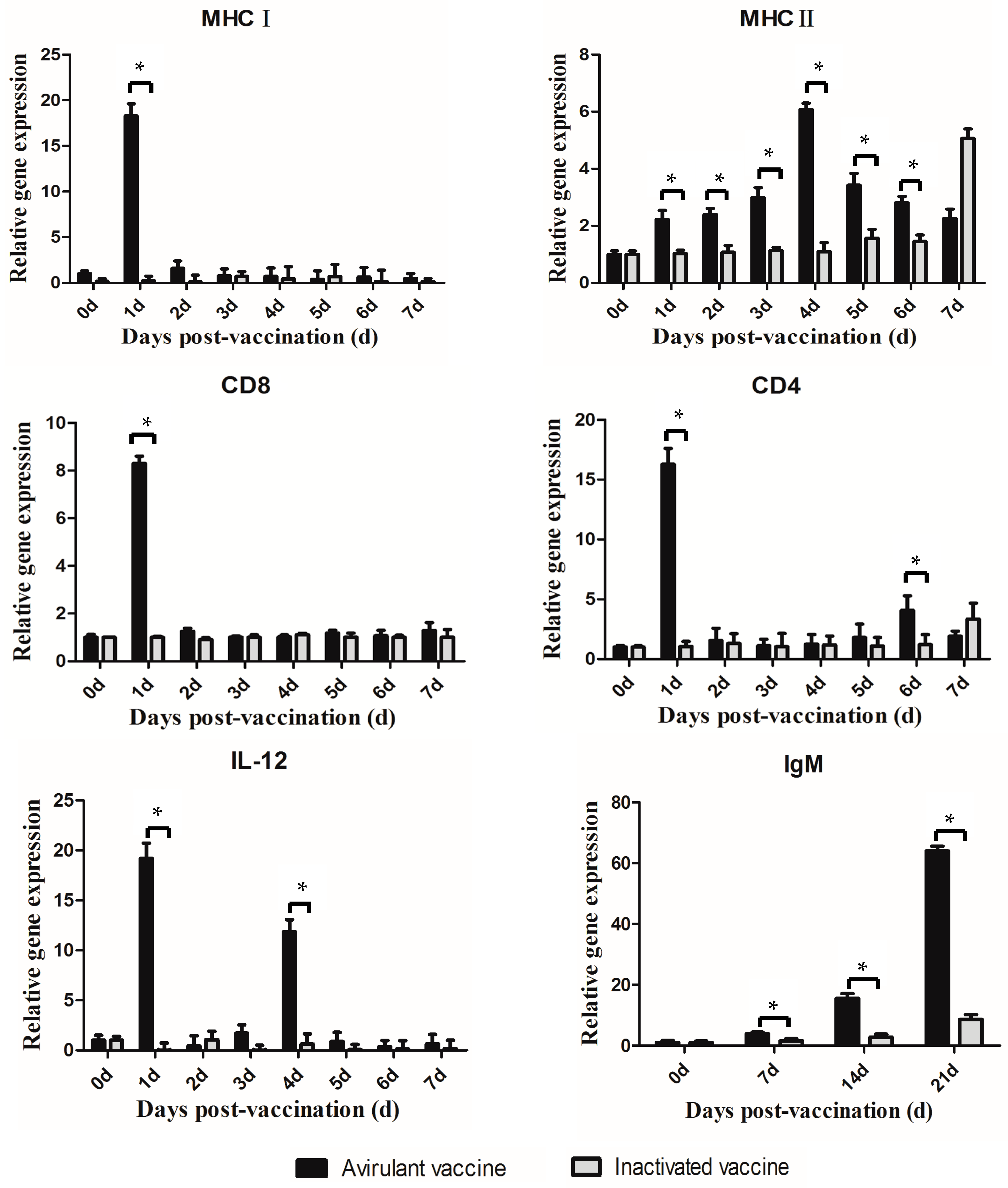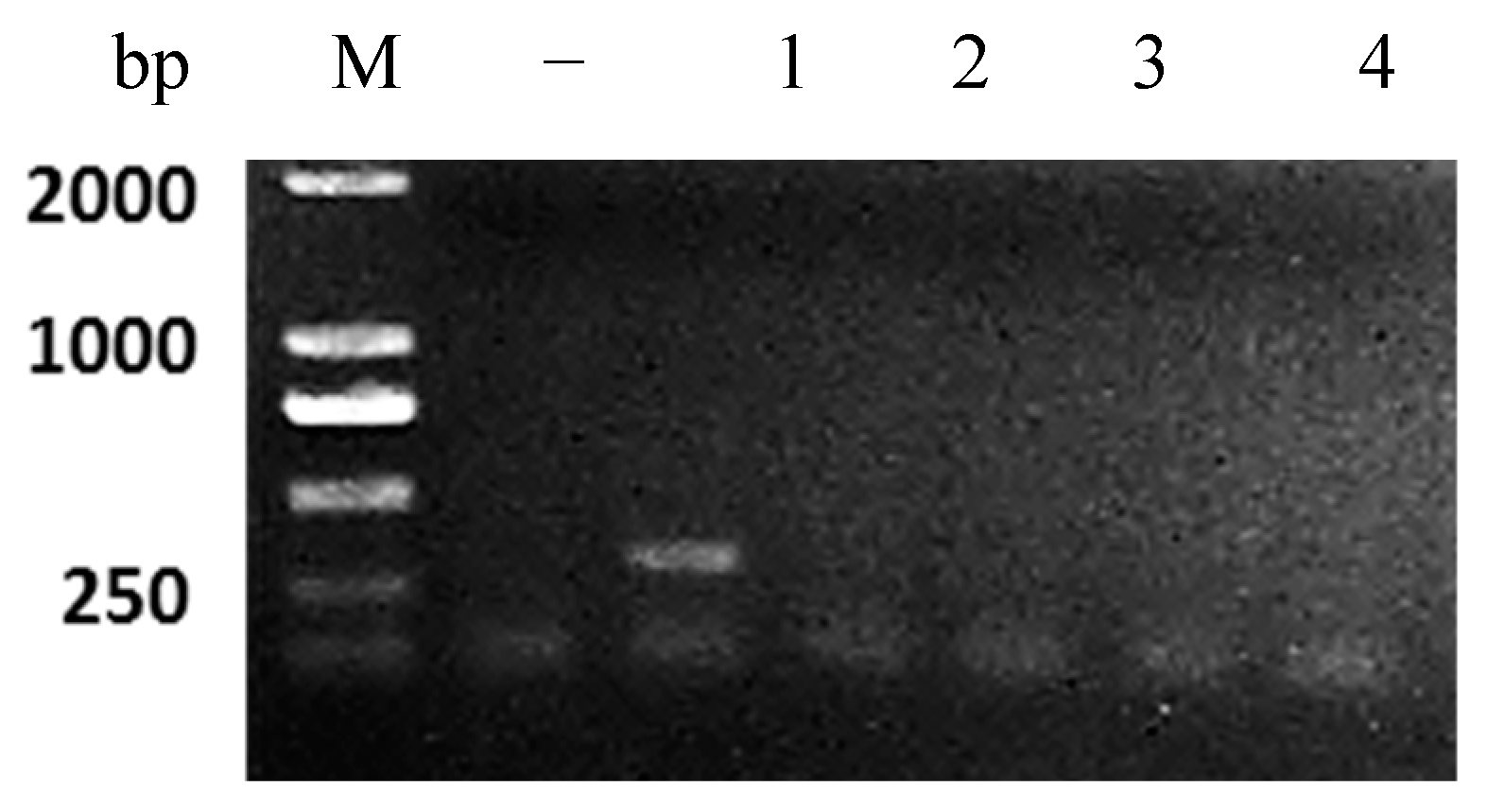An Avirulent Largemouth Bass Birnavirus Vaccine Candidate Protects Largemouth Bass against Birnavirus Infection
Abstract
:1. Introduction
2. Materials and Methods
2.1. Fish, Cell Line, and Viruses
2.2. Total RNA Extraction and Reverse Transcription
2.3. Screening of the Avirulent LBBV Strain
2.3.1. Viral Titer Determination in CPB Cells
2.3.2. Determination of Virulence of Different Isolates with Challenge Experiment
2.4. Dynamics of the Avirulent Strain In Vitro and In Vivo
2.5. Immune Protection Evaluation
2.5.1. Vaccine Preparation
2.5.2. Evaluation of Antigenicity
2.5.3. Determining LBBV Load of Dead Fish with Real-Time PCR
2.5.4. Transcription of Immune-Related Genes Post Vaccination
2.6. Safety Evaluation of Avirulent Vaccine
2.7. Statistical Analysis
3. Results
3.1. Screening of the Avirulent Largemouth Bass Birnavirus Strain
3.2. Dynamics of the Avirulent Strain In Vitro and In Vivo
3.3. The Kinetics of Immune-Related Gene Expression in Different Vaccine Groups
3.4. Immune Protection of Different Vaccines against the LBBV Challenge
3.5. LBBV Loads of the Dead Fish in Different Groups
3.6. Virulence Reversion Test of the Avirulent Vaccine
4. Discussion
5. Conclusions
Author Contributions
Funding
Institutional Review Board Statement
Informed Consent Statement
Data Availability Statement
Conflicts of Interest
References
- Bureau of Fisheries of the Ministry of Agriculture of the People’s Republic of China. China Fishery Statistical Yearbook—2022; China Agriculture Press: Beijing, China, 2022.
- Deng, G.; Li, S.; Xie, J.; Bai, J.; Chen, K.; Ma, D.; Jiang, X.; Lao, H.; Yu, L. Characterization of a ranavirus isolated from cultured largemouth bass (micropterus salmoides) in China. Aquaculture 2011, 312, 198–204. [Google Scholar] [CrossRef]
- Ma, D.; Deng, G.; Bai, J.; Li, S.; Yu, L.; Quan, Y.; Yang, X.; Jiang, X.; Zhu, Z.; Ye, X. A strain of Siniperca chuatsi rhabdovirus causes high mortality among cultured largemouth bass in south china. J. Aquat. Anim. Health 2013, 25, 197–204. [Google Scholar] [CrossRef]
- Fu, X.; Luo, M.; Zheng, G.; Liang, H.; Liu, L.; Lin, Q.; Niu, Y.; Luo, X.; Li, N. Determination and characterization of a novel birnavirus associated with massive mortality in largemouth bass. Microbiol. Spectr. 2022, 10, e171621. [Google Scholar] [CrossRef] [PubMed]
- Delmas, B.; Attoui, H.; Ghosh, S.; Malik, Y.S.; Mundt, E.; Vakharia, V.N.; ICTV Report Consortium. ICTV virus taxonomy profile: Birnaviridae. J. Gen. Virol. 2019, 100, 5–6. [Google Scholar] [CrossRef] [PubMed]
- Bernard Delmas, H.A.S.G. Virus Taxonomy the ICTV Report on Virus Classification and Taxon Nomenclature Birnaviridae Chapter; International Committee on Taxonomy of Viruses Elsevier/Academic Press: London, UK, 2020. [Google Scholar]
- Wolf, K.; Snieszko, S.F.; Dunbar, C.E.; Pyle, E. Virus nature of infectious pancreatic necrosis in trout. Proc. Soc. Exp. Biol. Med. 1960, 104, 105–108. [Google Scholar] [CrossRef]
- Roberts, R.J.; Pearson, M.D. Infectious pancreatic necrosis in atlantic salmon, Salmo Salar. J. Fish Dis. 2005, 28, 383–390. [Google Scholar] [CrossRef] [PubMed]
- Fu, X.; Li, N.; Lai, Y.; Luo, X.; Wang, Y.; Shi, C.; Huang, Z.; Wu, S.; Su, J. A novel fish cell line derived from the brain of chinese perch Siniperca chuatsi: Development and characterization. J. Fish Biol. 2015, 86, 32–45. [Google Scholar] [CrossRef]
- Reed, L.J.M.H. A simple method of estimating fifty percent end points. Am. J. Hyg. 1938, 27, 493–497. [Google Scholar]
- Luo, M.; Li, N.; Lin, Q.; Niu, Y.; Liu, L.; Liang, H.; Luo, X.; Fu, X. Establishment and application of the nested RT-PCR for the detection of a novel largemouth bass birnavirus (LBBV). J. Fish. China 2021, 45, 1584–1591. [Google Scholar]
- Horne, M.T. Technical aspects of the administration of vaccines. Dev. Biol. Stand. 1997, 90, 79–89. [Google Scholar]
- Gomez-Casado, E.; Estepa, A.; Coll, J.M. A comparative review on european-farmed finfish RNA viruses and their vaccines. Vaccine 2011, 29, 2657–2671. [Google Scholar] [CrossRef] [PubMed]
- Su, H.; Su, J. Cyprinid viral diseases and vaccine development. Fish Shellfish Immunol. 2018, 83, 84–95. [Google Scholar] [CrossRef] [PubMed]
- Ma, J.; Bruce, T.J.; Jones, E.M.; Cain, K.D. A review of fish vaccine development strategies: Conventional methods and modern biotechnological approaches. Microorganisms 2019, 7, 569. [Google Scholar] [CrossRef]
- Martinez-Alonso, S.; Vakharia, V.N.; Saint-Jean, S.R.; Perez-Prieto, S.; Tafalla, C. Immune responses elicited in rainbow trout through the administration of infectious pancreatic necrosis virus-like particles. Dev. Comp. Immunol. 2012, 36, 378–384. [Google Scholar] [CrossRef] [PubMed]
- O’Brien, C.A.; Pegg, C.L.; Nouwens, A.S.; Bielefeldt-Ohmann, H.; Huang, B.; Warrilow, D.; Harrison, J.J.; Haniotis, J.; Schulz, B.L.; Paramitha, D.; et al. A unique relative of rotifer birnavirus isolated from australian mosquitoes. Viruses 2020, 12, 1056. [Google Scholar] [CrossRef]
- Rivas-Aravena, A.; Cortez-San, M.M.; Galaz, J.; Imarai, M.; Miranda, D.; Spencer, E.; Sandino, A.M. Evaluation of the immune response against immature viral particles of infectious pancreatic necrosis virus (IPNV): A new model to develop an attenuated vaccine. Vaccine 2012, 30, 5110–5117. [Google Scholar] [CrossRef]
- Li, S.; Hu, Y.; Li, X.; Han, S.; Zhang, B.; Yan, Z.; Xue, R.; Gao, Q.; Wu, J.; Zhao, X.; et al. Development of a live vector vaccine against infectious pancreatic necrosis virus in rainbow trout. Aquaculture 2020, 524, 735275. [Google Scholar] [CrossRef]
- Huilan, Y.; Cui, Z.; Jianyong, F.; Lei, G.; Wei, Q. Construction of, and t-helper (th)1/th2 immune responses to, a herpes simplex virus type 2 glycoprotein D-cytotoxic t-lymphocyte epitope DNA vaccine. Clin. Exp. Dermatol. 2010, 35, 537–542. [Google Scholar] [CrossRef]
- Wang, X.; Zhang, A.; Qiu, X.; Yang, K.; Zhou, H. The il-12 family cytokines in fish: Molecular structure, expression profile and function. Dev. Comp. Immunol. 2023, 141, 104643. [Google Scholar] [CrossRef]
- Filippatos, F.; Tatsi, E.B.; Michos, A. Immune response to SARS-CoV-2 in children: A review of the current knowledge. Pediatr. Investig. 2021, 5, 217–228. [Google Scholar] [CrossRef]
- Shoemaker, C.A.; Klesius, P.H.; Drennan, J.D.; Evans, J.J. Efficacy of a modified live flavobacterium columnare vaccine in fish. Fish Shellfish Immunol. 2011, 30, 304–308. [Google Scholar] [CrossRef] [PubMed]
- Shoemaker, C.A.; Klesius, P.H.; Evans, J.J. Immunization of eyed channel catfish, ictalurus punctatus, eggs with monovalent flavobacterium columnare vaccine and bivalent F. columnare and Edwardsiella ictaluri vaccine. Vaccine 2007, 25, 1126–1131. [Google Scholar] [CrossRef] [PubMed]
- Saito, H.; Okamura, T.; Shibata, T.; Kato, G.; Sano, M. Development of a live attenuated vaccine candidate against herpesviral hematopoietic necrosis of goldfish. Aquaculture 2022, 552, 737974. [Google Scholar] [CrossRef]






| Gene Name | Accession NO. | Primer Name | Sequence(5′-3′) | Application |
|---|---|---|---|---|
| VP1 | MW727623.1 | LBBV-qF LBBV-qR Probe | AATCCAAAAACAACACGCTAAACA GCGCCTCATGATTGAGTCAAG (FAM)-ATGGGTTCAATCCCTTCAACGGCG-(Eclipse) | LBBV load |
| LBBV-F LBBV-R | CCTGTCGTGCGGGCTCCTATT CTCTTTGTGGCGTTGGCTTCG | Virulent reversion test | ||
| IL-12bβ | XM_038708060.1 | IL-12-F IL-12-R | TCTTCCATCCTTGTGGTCTTCC CAGTTCCAGGTCAAAGTGGTC | Gene expression |
| MHCIα | XM_038725867.1 | MHCI-F MHCI-R | GTGGTTCAACGTCAACATCG ACCCAGACTTGTTCGGTGTC | |
| MHCIIα | XM_038711500.1 XM_038711494.1 | MHCII-F MHCII-R | TCTACCCTGCAGAAGAAGCTCA CTCACTGGACGACCATTTTTAGTC | |
| CD8α | XM_046076130.1 | CD8-F | GCATTTATAGCTGCGGTTTGC | |
| CD8-R | GTTTGGCGGTGGTCCGTGTT | |||
| CD4 | XM_038711094.1 XM_038711102.1 | CD4-F CD4-R | TGGTATCATCGTGGTAACTTCA AGCATCTTCTTCCTTCACTCCC | |
| IgM-H | MN871984.1 | IgM-F IgM-R | TGGTGACCCTGACTTGCTATG GAGTCTGCTTCCTCGTCATCAAC | |
| 18SrRNA | XR_005442393.1 | 18S-F 18S-R | GGACACGGAAAGGATTGACAG CGGAGTCTCGTTCGTTATCGG |
Disclaimer/Publisher’s Note: The statements, opinions and data contained in all publications are solely those of the individual author(s) and contributor(s) and not of MDPI and/or the editor(s). MDPI and/or the editor(s) disclaim responsibility for any injury to people or property resulting from any ideas, methods, instructions or products referred to in the content. |
© 2023 by the authors. Licensee MDPI, Basel, Switzerland. This article is an open access article distributed under the terms and conditions of the Creative Commons Attribution (CC BY) license (https://creativecommons.org/licenses/by/4.0/).
Share and Cite
Fu, X.; Luo, M.; Lin, Q.; Liang, H.; Niu, Y.; Luo, X.; Ma, B.; Li, N. An Avirulent Largemouth Bass Birnavirus Vaccine Candidate Protects Largemouth Bass against Birnavirus Infection. Vaccines 2023, 11, 1740. https://doi.org/10.3390/vaccines11121740
Fu X, Luo M, Lin Q, Liang H, Niu Y, Luo X, Ma B, Li N. An Avirulent Largemouth Bass Birnavirus Vaccine Candidate Protects Largemouth Bass against Birnavirus Infection. Vaccines. 2023; 11(12):1740. https://doi.org/10.3390/vaccines11121740
Chicago/Turabian StyleFu, Xiaozhe, Mingju Luo, Qiang Lin, Hongru Liang, Yinjie Niu, Xia Luo, Baofu Ma, and Ningqiu Li. 2023. "An Avirulent Largemouth Bass Birnavirus Vaccine Candidate Protects Largemouth Bass against Birnavirus Infection" Vaccines 11, no. 12: 1740. https://doi.org/10.3390/vaccines11121740




